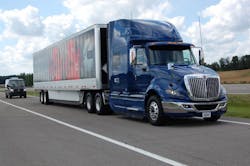EAST LIBERTY, OH. The new “next-generation X family” of 2017-compliant diesel truck engines introduced by Cummins during a media event here at the 4,500-acre Transportation Research Center (TRC) proving grounds features a new array of soon-to-be-available options aimed at making these new 15-liter and 12-litre engines more efficient while lowering cost of operation and lifecycle expense.
For example, the 15-liter X15 Efficiency Series will offer a 50,000 mile extended oil drain interval for typical line-haul applications, depending on duty cycle, which can be lengthened to as much as 80,000 miles for trucks running at 6.5 mpg or higher with its new “OilGuard” service – an oil analysis program crafted by the OEM based in part on the 9 million miles of field testing its new X family of engines underwent, explained Tim Proctor, technical leader for heavy-duty engineering.
That testing, which not only included ongoing “trend line analysis” of the engine oil, also witnessed use of “degraded oil” within the test engines to highlight areas where different materials to prevent bearing surface pitting, for instance, would allow for longer drain intervals, Proctor noted.
On the electronic front, every X15 and X12 engine will be “factory-ready” to enable over-the-air (OTA) engine programming and customization when connected to a telematics system, which will allow for the use – at the fleet’s discretion – of the new “Connected Calibrations” service Cummins plans to offer.
Steve Hammer, director of data enhanced services for Cummins’ distribution business division, told Fleet Owner that “Connected Calibrations” will act much like an operating system update to a smartphone or tablet computer – with the key difference being that the fleet decides whether or not to download that update.The encrypted software package will be delivered to each customer’s truck where it will wait in a virtual “holding area” until the driver signals the truck is in safe position – typically parked for the evening – to receive the update, Hammer said. Once safe, the fleet manager “pushes a button” to commence the download – a download that usually takes five minutes to complete and that can occur for every truck in the fleet or only for select units.
“Why is this important? About every one to two years we’ve gathered enough data to realize a certain calibration change can improve performance, fuel economy, even extend engine life,” he said. “Doing this OTA means all of the updates are done in a day, rather than pulling each truck into a shop and connecting it to a computer for the download over a three month period – a stretch of time where a fleet may forget which trucks it’s updated and which ones it hasn’t.”
Cummins added that there is a “fail safe” mode for such OTA updates, meaning that the engine will revert to its original settings if a problem with the download occurs.
Cummins executives explained that new calibrations delivered through a fleet’s telematics to its engines are held “off line” until the download process begins – so as not to interfere with a truck while it is operating – and that the “old” calibrations are kept by the engine’s electronic control module (ECM) until the new download is determine“Connected Tuning” is a subset of “Connected Calibrations” that Cummins is now testing and hopes to make available to X15 engine family customers “soon,” Hammer noted.
It’s aimed letting customers specifically “tune” each of their trucks by adjusting the 400 or so “parameters” within each calibration package, he pointed out; “tuning” that can occur on a daily, weekly, or monthly basis, depending on what kind of duty cycle the vehicle is engaged in.
“Let’s say one week you are hauling toilet paper and the next steel coils,” he said. “You can ‘tune’ the engine to match the requirements for hauling those loads to get the best fuel economy and/or performance possible.” And it’s all done from central headquarters via the fleet’s telematics system, Hammer stressed.
He added that “Connected Tuning” is currently in early validation trials so no release date is being set for it yet.
Finally, Cummins is rolling out a new “predictive cruise control” feature for its new engines that will be able to “look ahead” up to two miles down the road so the engine and transmission can “plan” together better in order to maximize fuel economy.
That cruise control feature will be added to Cummins’ existing ADEPT offerings SmartTorque2 and SmartCoast. Those two functions alone can help a truck in highway operation achieve up to a 3% increase in fuel economy, noted Cummins engineer Dan Dempsey. Combined with predictive cruise, that ADEPT suite can offer the potential for up to a 6% gain in fuel economy, he said.
Dempsey that an aftermarket “package” offering all three of those electronic features will be made available in the fourth quarter of this year, which will allow truck owners with older Cummins engines to add those electronic features to their units.
“It’s improving fuel efficiency over specific routes for trucks,” he said.
About the Author
Sean Kilcarr
Editor in Chief
Sean Kilcarr is a former longtime FleetOwner senior editor who wrote for the publication from 2000 to 2018. He served as editor-in-chief from 2017 to 2018.



